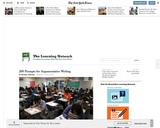
This resource contains a list of questions for students to answer in argumentative or persuasive essays.
- Subject:
- English Language Arts
- Material Type:
- Activity/Lab
- Provider:
- New York Times
- Author:
- The Learning Network
- Date Added:
- 04/23/2017

This resource contains a list of questions for students to answer in argumentative or persuasive essays.
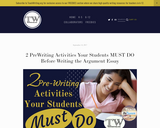
This resource details prewriting strategies for students to employ when writing arguments.

This resource from the New York Times contains 301 prompts and connections for student discussion and arguementative writing.

In this activity, students will work in collaborative groups to develop an advertisement for a political candidate in support of one side of an issue - should we build low-cost housing on part of the land presently occupied by an estuary? Each group will decide which side they want to support - either for or against building the housing - and write an ad that will be run in a local paper, or that will be viewed on local TV, to support their argument.

This lesson and resource helps students strengthen their persuasive writing by identifying and responding to counterarguments.
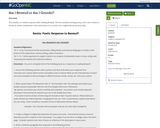
This activity is a creative response after reading Beowulf. This has students writing poetry, and it also contains a hands-on artistic component in the instructions. It is a remix of an original lesson by Kinsi King.

In this lesson, students will compare/contrast the information in their textbook about Andrew Jackson to political cartoons of the era. Students will identify symbols, allusions and stereotypes used in these cartoons and infer the intended message and tone of the Jackson era cartoons. Students will also identify any biases in the cartoons and check for historical accuracy, and then formulate their own opinion about the Jackson Administration. As a culminating activity, students will write an opinion essay that articulates their personal stance on Andrew Jackson’s character, using proper writing conventions.
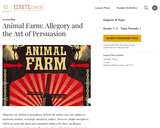
Allegories are similar to metaphors: in both the author uses one subject to represent another, seemingly unrelated, subject. However, unlike metaphors, which are generally short and contained within a few lines, an allegory extends its representation over the course of an entire story, novel, or poem. This lesson plan will introduce students to the concept of allegory by using George Orwell’s widely read novella, Animal Farm, which is available on Project Gutenberg.

In this lesson, students use peer evaluations as a means to strengthen an argumentative essay. Students will revise the essay and prepare a final submission.

A teachers guide for Before My Eyes by Caroline Bock, including in-depth insight to the setting, characters, and author's inspiration, questions for class discussion, and activities to provoke deeper understanding of issues
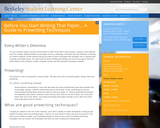
This resource discusses techniques for prewriting and organizing ideas.
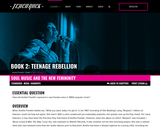
In this lesson, students will watch a 25-minute video, Aretha Franklin ABC News Close Up (1968), as a pre-lesson activity. In class, students examine a timeline of landmark events that occurred during the women's movement from 1961 to 1971. While watching multiple live performances of Aretha Franklin, including "Dr. Feelgood," "Do Right Woman," "Respect," "(You Make Me Feel Like) A Natural Woman," and "Chain of Fools," students will seek to identify Gospel influences and investigate whether issues related to women's rights are reflected in the songs as well. The extension activity includes an insightful personal narrative that provides an account of sexism that existed during the Civil Rights era.
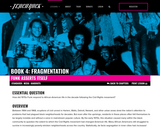
In this lesson, students investigate a collection of musical performances, television interviews, and movie trailers, discussing how black artists of the 1970s, including James Brown, George Clinton, and Curtis Mayfield, addressed black audiences through the music and aesthetics of Funk, casting a light on all that the Civil Rights movement could not do for a racially divided America.
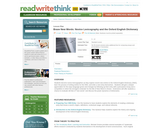
Students become novice lexicographers as they explore recent new entries to the Oxford English Dictionary (OED), learn the process of writing entries for the OED, and write a new entry themselves. Students will follow up their entry with a persuasive essay and a competition in which the strongest contender for the title of New Word is chosen. Extensions will offer students a chance to evaluate old lists of "new words" and discuss the power dynamics of dictionaries.

A 4 minute video on removing vague, ambigous words like 'good' and 'bad' from student writing.
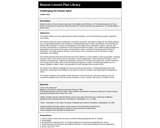
Students select a theme-related essay topic from Night, by Elie Wiesel, or The Metamorphosis, by Franz Kafka, and develop an essay that relates the theme to modern day personal experiences. The essay follows a preset rubric.
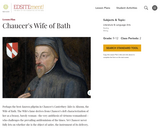
This lesson helps students understand the complexities of The Wife of Bath's character and the rhetoric of her argument by exploring the various ways in which Chaucer crafts a persona for her. After familiarizing themselves with the framing narrative of the Canterbury Tales and its language, students study the Wife of Bath as a character. Finally, students examine several primary source documents written about women and marraige in order to understand the context in which the Wife presents her argument.
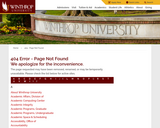
This two-page handout details the elements of an argumentative essay.

In this lesson, students investigate climate change and search for and evaluate evidence of change. Students will then write a scientific argument using evidence and reasoning to support claims. Students will also be able to reflect on the weaknesses in their own arguments in order to improve their argument and then respond to other arguments.

This resource provides a lesson which is designed to provide students with the opportunity to perform a close reading of a text. Students will respond to the provided text dependent questions, outline the text, and complete a comparitive essay.